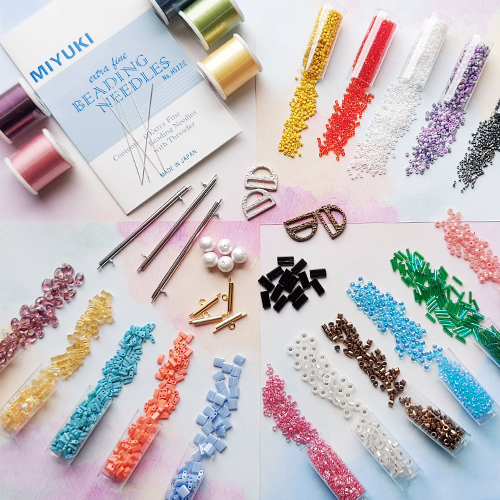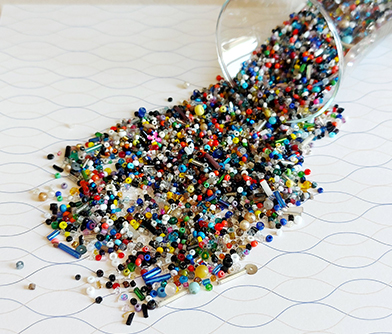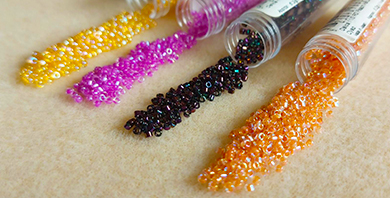| How Many Miyuki Beads Do I Need? |
When it comes to bead patterns, there are no hard and fast rules as to how they should be written. Some designers like to list the full weight of each of the beads that you'll use, others will list the number of beads. In the latter case, that can be helpful if it's just a handful of beads, as hopefully we can use our stash beads for that, right? But what if it's a higher number? Who really wants to sit there and count out beads in a certain colour (and let's be honest, by the time we've counted them out they'll probably get knocked over by our friendly dog/cat/child/gust of wind or you'll get brain freeze and start second guessing the number you've just counted)!
| Perhaps you're a pattern designer yourself, and you've just created a fab new design that you're going to take to market. When it comes to writing your pattern, do you go with the weight or number of beads? When one of our team used to make bead loomed bracelets, she'd design them using simple graph paper then have to count up all the different beads in the design on paper, before then going on to count out the beads themselves. Tedious but necessary to make sure she'd have enough to make the bracelet. Surely there was a quicker way? |
|
Stand up and take a bow - bead quantities per gram!
Knowing how many beads you'll get to the gram is a great way of working out exactly how many beads you'll need to buy, or how many you've got left in the tube that's half full (or is it half empty?!). And if you're writing patterns, then you'll be able to give either the bead weights or numbers required, giving your customers a much better shopping experience.
| Now, before we go on, just take a moment to remember that all the following information on bead quantities is always an approximation. That's because the colour coating or finish that's applied to the bead can affect the number of beads per gram. |
For example, beads with a frosted or matte finish tend to be lighter than those with a metal plating, so you'll get more to the gram. We'd always suggest that when working out your bead quantities, always make sure you've got enough spare to play with as there's nothing worse than almost finishing a project and running out of beads.
Miyuki has, very helpfully, created a list of their beads, along with how many you can expect to get per kilogram. You can see this here
You'll also see on the guide that an individual bead's weight is also denoted. if you're looking at just a handful of beads for your pattern, you can also use this to work out their weight equivalent too.
As it's rare that our customers buy beads by the kilogram, we've put our maths hats on and created a simple table showing how many Miyuki beads per gram and per typical pack size that you'll get from us (remember this is just an approximation, and some bead coatings, such as 24kt, will have a smaller pack size):
| Delica Beads | Amount per Gram | Amount per Typical Pack of 5.2g |
| 15/0 - DBS | 350 | 1,820 |
| 11/0 - DB | 200 | 1,040 |
| 10/0 - DBM | 108 | 561 |
| 8/0 - DBL | 30 | 156 |
| Seed Beads | Amount per Gram | Amount per Typical Pack |
| 15/0 | 290 | 8.2g = 2,378 |
| 11/0 | 110 | 22g = 2,420 |
| 8/0 | 38 | 22g = 836 |
| 6/0 | 15 | 20g = 300 |
| Bead Type | Amount per Gram | Amount per Typical Pack of 5.2g |
| Tila | 11 | 57 |
| Half Tila | 25 | 130 |
| Quarter Tila | 48 | 249 |
| Bead Type | Amount per Gram | Amount per Typical Pack of 20g |
| 1.8mm Cube (Square) | 87 | 1,740 |
| 3mm Cube (Square) | 21 | 420 |
| 4mm Cube (Square) | 12 | 240 |
We hope you find these tables and the Miyuki guide helpful for your next bead calculations!



